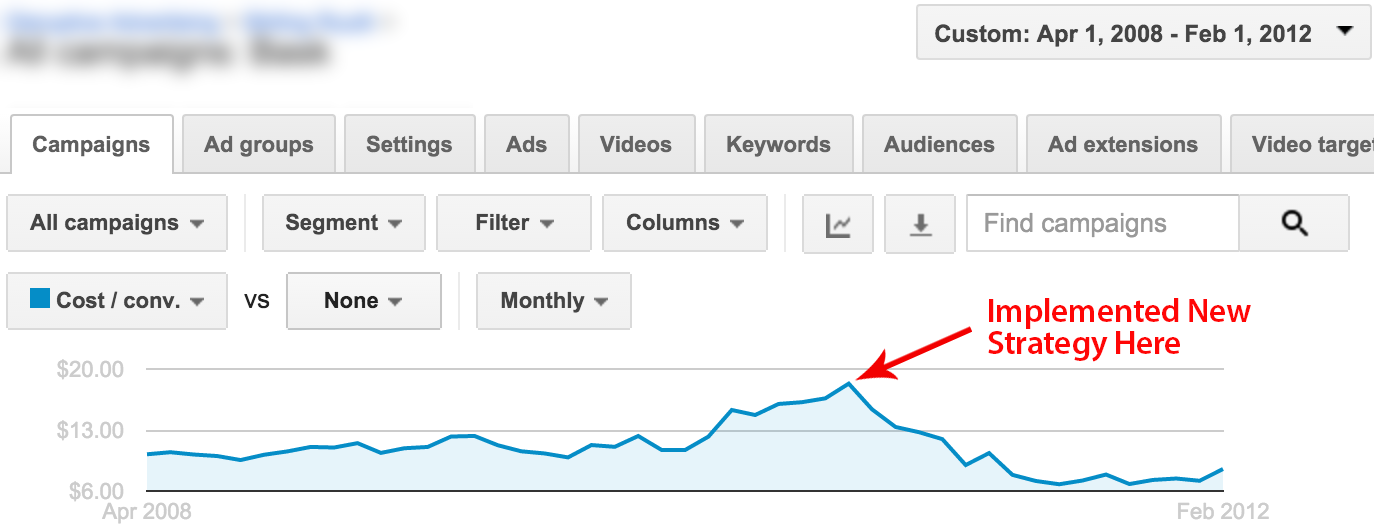KISSmetrics: What’s Your Analytics Data Worth?
KISSmetrics: What’s Your Analytics Data Worth? |
| What’s Your Analytics Data Worth? Posted: 15 Mar 2016 11:33 AM PDT It can often be hard to nail down the exact worth of analytics data. For most companies, data doesn't have any inherent worth. No one comes to your site and says, "Hey, I see you've got a nice web analytics setup. Can I pay you for your data?" It also takes work to get value out of your analytics data, which is why so many companies don't set up analytics or don't use their analytics setup. However, the data most companies are ignoring has value—a lot of value. Analytics is valuable in two ways: 1) it shows you where you are wasting money and 2) it reveals new opportunities for growth. Let's look at a couple of case studies that demonstrate the value of analytics data in each of these areas: Are You Wasting Your Marketing Budget?The goal of marketing is to produce profitable sales. That’s it, end of story. It doesn’t matter whether it’s a branding play or a high-intent, low-volume PPC campaign, the goal of marketing is to produce more revenue and profit for a business. In other words, if a campaign isn’t producing profitable sales, it’s not a successful campaign. The problem is, according to HubSpot, only about half of companies track return-on-investment (ROI) for their online marketing. That means half of online advertisers have no idea whether or not their marketing is even working!  Simply tracking ROI isn’t enough, though. You can know your overall marketing efforts are profitable and still waste a ton of money on individual campaigns. Case StudyFor example, last year I audited the AdWords account of a potential client. They were in the half of marketers with analytics data, however, they weren’t using it to guide their marketing decisions. After managing their advertising in house for several years, they were generating leads at a decent clip and made a lot of money on each sale. However, their cost-per-conversion was so high that they weren't actually making any money off of their campaigns. In the hopes of improving things, they had recently increased their budget by 30% only to find that generating more unprofitable traffic doesn’t make you more profitable. It was at this point that I started looking at their account. They had the budget and profit margins to succeed at pay-per-click, but something just wasn't working. Here’s what their 90-day history looked like: As you can see, over the past 3 months they had spent a lot of money to get about 1 conversion per 500 impressions. At 8 million impressions, though, that was a lot of leads. But what about sales? Unfortunately, only 1 out of every 100 leads became a paying customer, which meant their cost-per-sale was about $2,000. Not a great situation. Clearly, a $20.29 cost-per-lead wasn’t good enough, so I took a closer look at where their money was actually going. After digging into their analytics data, it became clear that they were spending $49,000 a month on clicks that had never produced a single sale. In other words, they were spending 42% of their budget on the wrong audience. Ignoring Your Analytics Data is ExpensiveBy failing to use their analytics data, this client was wasting $49,000 a month. Simply eliminating that $49,000/month of useless ad spend would have dropped their cost-per-lead to $11.86 and their cost per sale to around $1,200, making their campaigns instantly profitable. Even better, if that $49,000/month had been invested in their effective campaigns, it would have produced an additional 4,150 leads and 41 sales per month. Between opportunity cost and wasted ad spend, this client was losing around $81,000 a month simply because they weren’t using their analytics data. Are You Missing Out On a Marketing Gold Mine?In addition to showing you where you’re losing money, your analytics data can also show you opportunities to make more money. Analytics data answers the question: who is interested in what you’re advertising? Often, it’s not who you think it is. Typically, certain market segments respond particularly well to a certain product, offer or advertising approach. If you can identify and specifically target those market segments, you can dramatically improve the performance of your advertising. To get at this data, you have to examine your target market in depth.  Here are some things to consider:
This sort of information isn’t always immediately obvious, sometimes you really have to dig for it. For example, location information should be readily available from most advertising or analytics platforms. For pain point insights, however, you might have to look at how ad content affects conversion rate across a range of different ads. If you haven’t been meticulous in testing different hypotheses, you may need to run some tests to start getting the analytics data you need. It’s a little extra work, but trust me, the results will be worth it. The thing is, once you actually dive into your data, you start make unexpected discoveries about who is really responding to which marketing campaigns. Case StudyFor example, one of my first AdWords clients operated in a highly competitive market, where the cost-per-click and cost-per-conversion had doubled over the previous 12 months. The company was good at turning conversions into sales, so their campaigns were profitable, but after months of fruitless campaign optimization, it looked like our cost-per-sale was simply as good as it was going to get. I’ve never been one to roll over and accept defeat, though, so I went through our analytics data in search of options. As I reviewed where our conversions and sales were coming from, I discovered that a significant portion of our sales were coming from a set of keywords that seemed largely unrelated to our current offering. More importantly, those keywords were converting at a 67% lower cost-per-conversion and had an enormous, virtually uncontested search volume. I quickly realized that I had uncovered a marketing gold mine and immediately began building campaigns around these untapped search terms. Almost overnight, our cost-per-conversion began to plummet. In fact, the new strategy was so effective that the company had a hard time hiring enough competent sales people to field all of the leads. Within a few years, the company grew from 25 employees to a staff of over 250! For this client, the secrets contained in their analytics data were worth well over $5 million in profit and millions in VC investment. ConclusionSo, what is your analytics data worth to you? For most companies, unlocking the secrets hidden in their analytics data can be worth tens-to-hundreds of thousands of dollars a month in additional revenue and reduced waste. In most cases, the difference between successful and unsuccessful marketing is how well you use your data. It takes extra time and effort to tease the value out of your analytics, but taking the time to do so can be worth millions to your business. What sort of value has your analytics data driven for your business? Do you think that data analysis is worth the effort? About the Author: Jacob Baadsgaard is the CEO and fearless leader of Disruptive Advertising, an online marketing agency dedicated to using PPC advertising and website optimization to drive sales. His face is as big as his heart and he loves to help businesses achieve their online potential. Connect with him on LinkedIn or Twitter. |
| You are subscribed to email updates from The Kissmetrics Marketing Blog. To stop receiving these emails, you may unsubscribe now. | Email delivery powered by Google |
| Google Inc., 1600 Amphitheatre Parkway, Mountain View, CA 94043, United States | |

